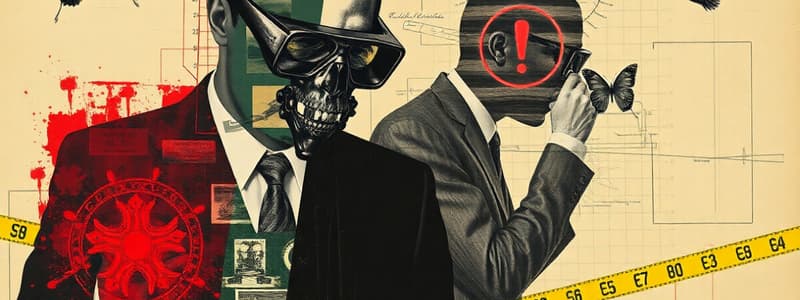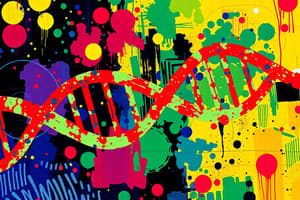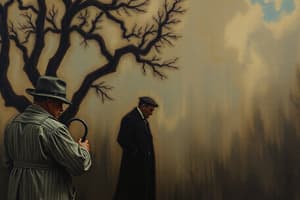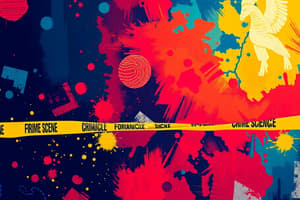Podcast
Questions and Answers
Which of the following best describes the role of forensic science?
Which of the following best describes the role of forensic science?
- Passing judgement on the guilt or innocence of a suspect.
- Creating laws that protect the public.
- Prosecuting criminals in a court of law.
- Providing a scientific basis for legal investigations. (correct)
Which expectation is part of the 'CSI effect'?
Which expectation is part of the 'CSI effect'?
- Every crime scene always contains forensic evidence that will support the case. (correct)
- Prosecutors' cases do not always need to be bolstered by forensic evidence.
- The use of forensic evidence usually hinders the progress of criminal investigations.
- Juries tend to give less weight to forensic evidence than to eyewitness testimony.
Archimedes' contribution to forensic science involved:
Archimedes' contribution to forensic science involved:
- Discovering a method to identify the composition of materials based on density and buoyancy. (correct)
- Writing 'The Washing Away of Wrongs', the first recorded application of medicine to solve crimes.
- Formalizing a system of classifying fingerprints.
- Developing the first optical microscope.
What characterizes the approach of key figures in forensic science during the mid-19th century?
What characterizes the approach of key figures in forensic science during the mid-19th century?
Victor Balthazard significantly advanced forensic science through his work in which area?
Victor Balthazard significantly advanced forensic science through his work in which area?
What was the main contribution of Alphonse Bertillon to forensic science?
What was the main contribution of Alphonse Bertillon to forensic science?
Sir Francis Galton's primary contribution to forensic science:
Sir Francis Galton's primary contribution to forensic science:
What is Locard's Exchange Principle?
What is Locard's Exchange Principle?
How does forensic science intersect with law?
How does forensic science intersect with law?
In the context of forensic science, what is an 'adversarial system'?
In the context of forensic science, what is an 'adversarial system'?
What is a key difference between a scientific hypothesis and a scientific theory?
What is a key difference between a scientific hypothesis and a scientific theory?
How does evolution relate to the concept of a scientific fact?
How does evolution relate to the concept of a scientific fact?
What is the significance of viewing the scientific method as 'non-linear'?
What is the significance of viewing the scientific method as 'non-linear'?
How does collaboration enhance the scientific process?
How does collaboration enhance the scientific process?
Why is creativity important in science?
Why is creativity important in science?
What does it mean to say that scientific conclusions are 'always revisable'?
What does it mean to say that scientific conclusions are 'always revisable'?
What is the main focus of a forensic scientist's work?
What is the main focus of a forensic scientist's work?
What is typically the education needed to become a CSI?
What is typically the education needed to become a CSI?
Where are public forensic laboratories funded from?
Where are public forensic laboratories funded from?
A forensic scientist specializing in biology is most likely to analyze?
A forensic scientist specializing in biology is most likely to analyze?
A forensic scientist specializing in chemistry is most likely to analyze?
A forensic scientist specializing in chemistry is most likely to analyze?
A forensic toxicologist would most likely test for:
A forensic toxicologist would most likely test for:
What kind of analyses would a forensic scientist specializing in documents be most likely to perform?
What kind of analyses would a forensic scientist specializing in documents be most likely to perform?
A forensic firearms examiners would typically perform which analysis?
A forensic firearms examiners would typically perform which analysis?
A forensic scientist specializing in electronics would most likely analyze which type of evidence?
A forensic scientist specializing in electronics would most likely analyze which type of evidence?
What activities might a professor of academic forensics engage in?
What activities might a professor of academic forensics engage in?
What is a type of legal proceeding?
What is a type of legal proceeding?
In a criminal case, what level of certainty must be established?
In a criminal case, what level of certainty must be established?
Who bears the burden of proving a defendant guilty beyond reasonable doubt?
Who bears the burden of proving a defendant guilty beyond reasonable doubt?
What is “voir dire”?
What is “voir dire”?
When is “re-direct” used?
When is “re-direct” used?
The American Academy of Forensic Sciences relate to which of the following?
The American Academy of Forensic Sciences relate to which of the following?
If a forensic scientist works in a police DNA lab, should they report unsupportive results?
If a forensic scientist works in a police DNA lab, should they report unsupportive results?
In what century did the modern forensic Laboratory begin?
In what century did the modern forensic Laboratory begin?
What is a summary of chapter 1?
What is a summary of chapter 1?
A forensic scientist only cares about
A forensic scientist only cares about
What does a forensic scientist do?
What does a forensic scientist do?
Considering Locard's Exchange Principle and the collaborative nature of forensic science, which scenario best illustrates the application of both concepts in a modern investigation?
Considering Locard's Exchange Principle and the collaborative nature of forensic science, which scenario best illustrates the application of both concepts in a modern investigation?
How did the shift from 'generalist' to 'specialist' roles influence the development of forensic science in the 20th century?
How did the shift from 'generalist' to 'specialist' roles influence the development of forensic science in the 20th century?
In a legal setting operating under an adversarial system, what is a critical ethical consideration for a forensic scientist presenting evidence?
In a legal setting operating under an adversarial system, what is a critical ethical consideration for a forensic scientist presenting evidence?
Considering the non-linear nature of the scientific method and its application in forensic science, which of the following most accurately describes the progression of a forensic investigation?
Considering the non-linear nature of the scientific method and its application in forensic science, which of the following most accurately describes the progression of a forensic investigation?
How does the concept of science being 'always revisable' impact the acceptance of forensic evidence in court?
How does the concept of science being 'always revisable' impact the acceptance of forensic evidence in court?
Flashcards
What is Forensic Science?
What is Forensic Science?
Science applied to legal investigations, intersecting science and law.
What is the CSI Effect?
What is the CSI Effect?
The unrealistic expectation that forensic evidence should always bolster a prosecutor's case.
What is Anthropometry?
What is Anthropometry?
The practice of using body measurements for identification.
What is Locard's Exchange Principle?
What is Locard's Exchange Principle?
Signup and view all the flashcards
What is Law?
What is Law?
Signup and view all the flashcards
What is Science?
What is Science?
Signup and view all the flashcards
What is a Hypothesis?
What is a Hypothesis?
Signup and view all the flashcards
What is a Scientific Theory?
What is a Scientific Theory?
Signup and view all the flashcards
What is a Fact?
What is a Fact?
Signup and view all the flashcards
What is Natural Selection?
What is Natural Selection?
Signup and view all the flashcards
How Science Works
How Science Works
Signup and view all the flashcards
Is science ever 'over'?
Is science ever 'over'?
Signup and view all the flashcards
Forensic scientist responsibilities?
Forensic scientist responsibilities?
Signup and view all the flashcards
Forensic scientist's day in court
Forensic scientist's day in court
Signup and view all the flashcards
Forensic science ethics
Forensic science ethics
Signup and view all the flashcards
Forensic Biology
Forensic Biology
Signup and view all the flashcards
Forensic Document Examination
Forensic Document Examination
Signup and view all the flashcards
Forensic Chemistry
Forensic Chemistry
Signup and view all the flashcards
Forensic Toxicology
Forensic Toxicology
Signup and view all the flashcards
Forensic Firearms & Toolmarks
Forensic Firearms & Toolmarks
Signup and view all the flashcards
Forensic Elctronics
Forensic Elctronics
Signup and view all the flashcards
Study Notes
- Science used in legal investigations
- Forensic science as a field encompasses Chemistry, Biology, Physics, Computer science, Medicine, Pharmacology, Anthropology/Archaeology, Marine science, Psychology.
- Forensic science sits at the intersection of science and the law.
What Forensic Science is Not
- Forensic science is not accurately portrayed in prime-time television shows like CSI, which have increased public awareness but created unrealistic expectations.
- Real forensic procedure can take days, weeks or even years, while on TV it only takes minutes.
- Not every crime scene yields forensic evidence that supports a case.
- The "CSI effect" is the unrealistic expectation that a prosecutor's case should be bolstered by forensic evidence.
- Jurors place a lot of weight on forensic evidence.
History of Forensic Science
- Pre-700 B.C.: Fingerprints were used on clay tablets for business transactions in ancient Babylon.
- 287-212 B.C.: Archimedes discussed how to prove a crown was not made of gold using density and buoyancy.
- 1235-1248 A.D.: Sung Tz'u's "The Washing Away of Wrongs" was released, marking the first recorded application of medicine for solving crimes.
- 1447 A.D.: Charles the Bold's missing teeth were used to identify his remains.
- 1590 A.D.: The first optical microscope was developed.
- Mid-19th Century is when forensic science begun to coalesce as a recognized discipline.
Key People in Forensic Science History
- Key people in the field of forensic science include Victor Balthazard, Alphonse Bertillon, Sir Francis Galton, Calvin Goddard, Hans Gross, Edmond Locard, and Mathieu Orfila.
- Most of these figures were generalists rather than specialists.
- Victor Balthazard (1852–1950): A French medical examiner who advanced fingerprint, firearm, and hair analysis in Paris.
- Victor Balthazard developed probability models for fingerprints and photographic methods for comparing bullet markings and wrote "The Hair of Man and Animals" first comprehensive book on hair analysis.
- Alphonse Bertillon (1853–1914): A French developed the first systematic method for identifying suspects and criminals called Anthropometry or Bertillonage.
- Anthropometry was based on 11 body measurements, descriptive information, and photographs, though fingerprints were not initially collected.
- Anthropometry was commonly used from 1883 to the early 1900s.
- Sir Francis Galton (1822–1911): An English who created the first classification system for fingerprints, with basic patterns like loop, arch, and whorl.
- Sir Francis Galton published "Finger Prints" in 1892, bringing fingerprinting to the forefront of criminal identification.
- Still considered a primary reference in the field
- Dr. Edmond Locard (1877–1966): A French with training in law and medicine, established a forensic laboratory in Lyon, France.
- Dr. Edmond Locard was interested in microscopic and trace evidence and believed it was crucial in linking people to places
- Dr. Edmond Locard is most famous for Locard's Exchange Principle usually paraphrased as "every contact leaves a trace".
Science and the Law Today
- Law settles disputes between individuals/the state (criminal law) or among individuals/entities (civil law).
- The law is guided by precedent and functions using an adversarial system.
- In a legal context, there are two opposing sides arguing for acceptance.
- Legal proceedings are outcome-based.
- The finder of fact or trier of fact, typically a judge or jury, determines the truth based on evidence presented by opposing sides.
- Science enables us to ask basic questions about the natural world, such as how the Earth formed and what governs the property of matter.
- Science helps answer questions using observation, testing, and interpretation through logic and scientific method.
- A good forensic scientist practices good science.
Scientific Definitions
- Hypothesis: A tentative explanation for an observation, phenomenon, or scientific problem that can be tested by further investigation.
- Scientific theory: An explanation of some aspect of the natural world that has been substantiated through repeated experiments or testing.
- Fact: A confirmed or agreed-upon empirical observation or conclusion, or knowledge based on real occurrences, not just a hunch or guess.
- The scientific theory that explains evolution is known as 'natural selection'.
- Darwin's theory explains that evolution has yet to be falsified, predicts nature.
How Science Works
- The core logic of science involves testing ideas with evidence.
- The scientific method is a framework for conducting research, often oversimplified like a recipe.
- The process of science is not linear.
- The process of science is iterative, circles back so that useful ideas are built upon other ideas.
- In any point of the process leads to many possible "next steps".
- Science depends on interactions within the scientific community and different parts of the process may be carried out by different people at different times
- The single scientist in a dark cellar is a thing of the past; team work is key.
- Team-work includes Crime Scene investigator (CSI), Scene of Crime Officers (SOCO), Forensic Identification Officer, and Forensic Scientists (specialists).
- Science is exciting, dynamic, and unpredictable that relies on creative people thinking outside the box
- Science should have no distinction between the "hard" and "soft" sciences and it should use good creative problem solving and solid methodology.
- Scientific conclusions are always revisable if warranted by the evidence, because science is falsifiable.
- Most scientists agree that science leads to an understanding of what is most likely to be correct at the current time with the available evidence.
Legal Proceedings
- Modern forensic science practice has been classified in legal proceedings
- The role of the forensic scientist is not concerned with the truth but only about the evidence.
- Forensic scientists will examine proper evidence collection, identifying the evidence, contamination issues, proper documentation, and clear communication of ideas.
- Training and education include the CSI, Forensic Scientists, Public laboratories, and Private laboratories.
- The training for CSI is police officers, general patrol, post-secondary education, SOCO police academies, forensic identification unit, and it is multi-disciplinary.
- Forensic Scientists training include scientists, technicians, undergraduate, postgraduate, based in laboratories or universities and it is a one discipline study.
- Public laboratories are generally government-funded, and private laboratories are designed to make a profit.
- Private laboratories mostly work with DNA and forensic toxicology.
- Forensic scientists work with, Biology, Chemistry, Toxicology, Documents, Firearms and Toolmarks, and Electronics
Academic Forensics
- Academic forensics include teaching science, mock crime scenes, curriculum development, and research.
- Types of legal proceedings include criminal and civil court proceedings.
- Criminal cases involve government and individual, or a violation of criminal laws such as Felony or Misdemeanor where guilty must be proven beyond a reasonable doubt (99%).
- Civil cases involve individuals and a "Lawsuit" or "being sued" such as patent infringements, where preponderance of evidence must be proven (51%).
- Jurisdictions have different legal rules and procedures such as local, state, federal, etc.
- Roles inside Legal Proceedings are trier and Finder-of-fact, Prosecution and Plaintiff, and a Defendant.
- The Prosecution bears the burden of proving a defendant guilty beyond reasonable doubt.
- Plaintiff proves the case by preponderance of the evidence.
- Forensic scientists can testify on either side.
- Forensic scientist's day in court happens with an analysis, is used to make the report and used to issue a Subpoena.
- Other requirements are Voir Dire to test the Background, training, and experience, Direct Examination must Lay foundation for the admissibility of the evidence question, and after that a Cross Examination can either discredit the witness or evidence and then Re-direct and Re-cross.
Ethics and Forensic Science
- There are no specific code of ethics, but there are ethics inside The American Academy of Forensic Sciences.
- The general rule is to do the best work, on every case that is submitted, providing a complete and honest report of findings, and testify with their scientific opinion based on the report and their knowledge in the field.
- Any difference of opinion between experts from the the same evidence are always ethical.
- Presents and defends; the trier of fact makes the ultimate decision.
- If you work in a police DNA lab, you would not have to have supportive results in their report, as you have to report all results as they are.
Studying That Suits You
Use AI to generate personalized quizzes and flashcards to suit your learning preferences.




